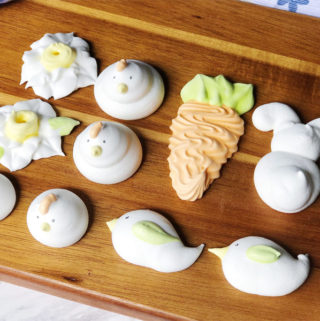
FRENCH MERINGUE
I want to draw your attention on the key points in making a gorgeous, glossy French meringue.
Ingredients
- 1 part egg whites
- 2 parts sugar
- few drops lemon juice
Instructions
- Thoroughly clean your mixing bowl, whisk attachment and any other dishes that will touch the egg whites, before you begin. You can use a splash of white vinegar or lemon juice.
- Very carefully separate the eggs into egg whites and yolks. Not a drop of water, fat or yolk should get into the egg whites.
- Weighing the egg whites and take twice as much sugar.
- Use a few drops of lemon juice, vinegar, or a pinch of cream of tartar to helps lower the ph and in turn strengthen the proteins and creates a more stable meringue.
- Start by whisking the egg whites on the low speed. When the white foam begins to appear, the mixer speed can be gradually increased.
- When the egg whites are beaten to soft picks, increase the mixer speed to medium high and add the sugar in slowly. I add about 1 tablespoon at a time and wait about 20-30 seconds before the next addition. Not rushing this process is key to making the mixture stable.
- After the sugar is all in, you need to whisk the meringue for another 4-5 minutes on high speed, so that the mixture becomes smooth, glossy, has a very stiff texture and the powder sugar has completely dissolved. Which you can check by rubbing a bit of the meringue between your fingers to make sure there are no undissolved sugar crystals left. The meringue should not feel gritty. If the meringue feels grainy, mix a few minutes more.